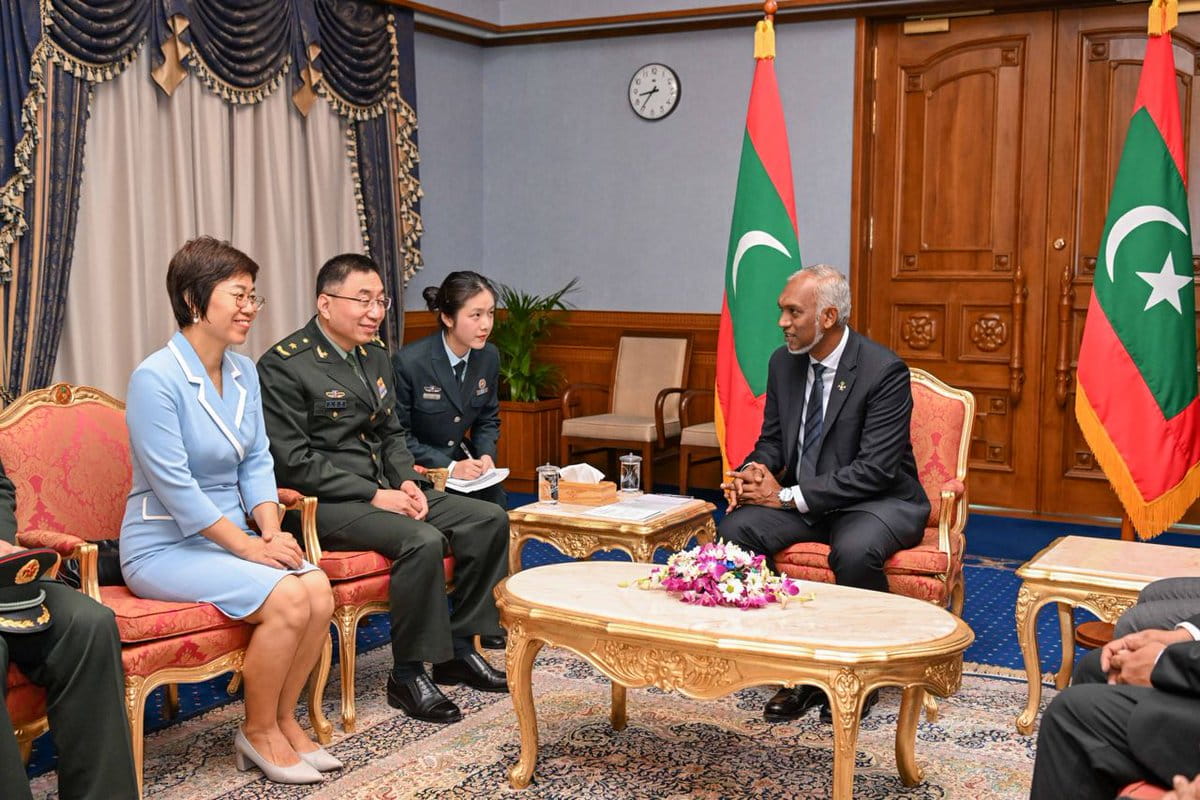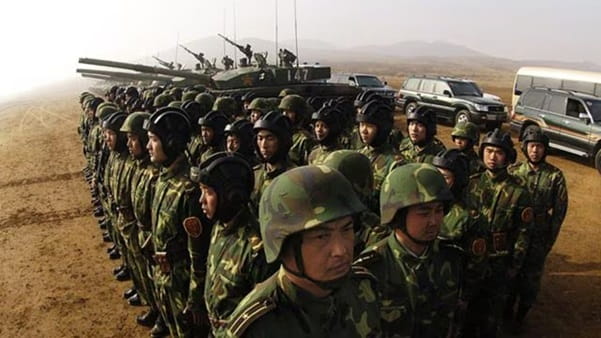
Major General Zhang Baoqun, Deputy Director of China’s Office for International Military Cooperation, meets Maldivian President Dr Mohamed Muizzu at the President’s Office, March 2024. | The President’s Office, Republic of Maldives

The most significant development in China’s South Asian engagement in 2024 was the realignment of the Maldives under President Mohamed Muizzu’s administration. The signing of a military assistance agreement in March during Major General Zhang Baoqun, Deputy Director of the Office for International Military Cooperation’s visit to Malé marked a watershed moment in enhancing bilateral defence cooperation. The Office for International Military Cooperation, established by President Xi Jinping in 2016, is a vertical under China’s Central Military Commission (CMC) responsible for coordinating the PLA’s relationship with foreign militaries, and Major General Zhang was on a tour to South Asia visiting the Maldives, Sri Lanka, and Nepal.
Introduction
Military diplomacy has emerged as a critical instrument in China's foreign policy toolkit, enabling Beijing to simultaneously expand its strategic influence while building lasting security partnerships. In South Asia, China's active military diplomacy in 2024 reflects Beijing's strategic pivot toward the Indian Ocean Region.
Through high-level delegations, naval deployments and joint exercises, China is systematically building military partnerships from Pakistan to Bangladesh and Nepal to the Maldives. This expansion marks a strategic recalibration of China's security approach, elevating South Asia from a peripheral concern to what Beijing now considers its “extended neighbourhood.”
The Maldives: A Strategic Pivot
The most significant development in China’s South Asian engagement in 2024 was the realignment of the Maldives under President Mohamed Muizzu’s administration. The signing of a military assistance agreement in March during Major General Zhang Baoqun, Deputy Director of the Office for International Military Cooperation’s visit to Malé marked a watershed moment in enhancing bilateral defence cooperation. The Office for International Military Cooperation, established by President Xi Jinping in 2016, is a vertical under China’s Central Military Commission (CMC) responsible for coordinating the PLA’s relationship with foreign militaries, and Major General Zhang was on a tour to South Asia visiting the Maldives, Sri Lanka, and Nepal.
President Muizzu’s announcement during his Presidential Address at the inaugural session of the People’s Majlis in 2024 on increasing the country’s military capabilities and developing round-the-clock surveillance capabilities over 900,000 square kilometre Exclusive Economic Zone of the Maldives offers avenues for Chinese involvement and raises questions about the potential dual-use technologies that may be deployed with Chinese assistance. President Muizzu, who campaigned on an “India Out” platform and demanded the replacement of Indian military personnel with civilians while simultaneously welcoming Chinese military delegations and research vessels, also chose to visit Beijing in January, before New Delhi.
This shift carries important implications given the Maldives’ location astride critical sea lanes. Chinese research vessel Xiang Yang Hong 3’s planned port call, while ostensibly for replenishment and personnel rotation, and its three month expedition off Maldivian waters, further signals Beijing’s intent to normalise its naval presence in the region.
Sri Lanka: The Balancing Act
Sri Lanka continues to perform a delicate balancing act between China and India. While it declined a port visit by the Chinese research vessel Xiang Yang Hong 3 in early 2024, it hosted multiple PLA Navy vessels throughout the year, including the Type 052D destroyer Hefei and the Type 071 landing platform docks Wuzhishan and Qilianshan in August, and the naval sailing training ship Po Lang in October. The naval hospital ship Peace Ark’s December visit , which combined medical diplomacy with a military presence and included a visit by Prime Minister Harini Amarasuriya, exemplified China’s sophisticated approach to expanding influence.
The technical stop in Sri Lanka by the Hefei, Wuzhishan and Qilianshan vessels on their way back from participating in the “Peace Unity-2024” joint exercise with Tanzania also demonstrate how the island nation is being incorporated into China’s broader military operations in the region. During its stop, professional exchanges and joint exercises and training were conducted. While Colombo maintains it is not taking sides, the frequency of Chinese naval visits suggests a growing comfort level with PLA Navy operations in proximity to Indian shores.
During his visit in March, Major General Zhang met key individuals in the Sri Lankan defence establishment including the Defence Secretary, General Kamal Gunaratne, and the Commander of the Navy, Vice Admiral Priyantha Perera and visited the Army’s School of Signals which focuses on training in military communications, information technology and electronic warfare, and discussed opportunities for collaboration.
Nepal: Reviving Military Engagement
In Nepal, Major General Zhang called upon Chief of Army Staff General Prabhu Ram Sharma and toured military installations. Discussions on military procurement, installation of an ammunition plant for the Nepal Army, resumption of the joint military exercise and training for Nepal Army officials were reported to have been part of the delegation's visit. In September, the two armies held joint training sessions in Chongqing, China, after a span of five years.
Bilateral military relations with Nepal have been the weakest amongst the BRI-participating nations in South Asia. The Covid-19 years led to subdued military ties and a revival began with Major General Yue Ande of the Tibet Military Command’s visit to Nepal in August 2023. While military relations remain relatively modest compared to other South Asian nations, China's focused engagement with Nepal's military establishment indicates a long-term strategy to establish a security presence along India's northern frontier.
Bangladesh: Deepening Military Ties
Bangladesh's political transition in 2024 provided China with opportunities to expand military influence. A Chinese naval fleet visit in October by the Type 680 Qi Jiguang naval training vessel and Type 071 Jinggangshan landing platform dock made it the first foreign fleet to do so since the interim government took over in Dhaka after Prime Minister Sheikh Hasina’s ouster. This visit also marked the first occasion in four years since a Chinese naval fleet last visited Bangladesh.
Earlier in the year, the inaugural “Golden Friendship-2024” joint exercise between Chinese and Bangladeshi armies was announced, marking a significant milestone in bilateral military relations. Focused on UN peacekeeping counter-terrorism operations, joint exercises with Bangladesh would provide China with an opportunity to shape Bangladesh’s military doctrine and operational procedures while creating interpersonal ties between the armed forces.
Since the interim government took over in August 2024, China has been presented with an opportunity to strengthen ties with the pro-China Bangladesh Nationalist Party (BNP ) and Jamaat-e-Islami Bangladesh (JIB) political parties. The political transition in the country presents significant opportunities for China to expand its engagement in Bangladesh. The growing Bangladesh-Pakistan relationship could also complement this endeavour. Furthermore, Bangladesh’s “Forces 2030” defence modernisation plan offers the potential for increased arms imports from China as the country is already a recipient of major Chinese armaments.
Pakistan: The Cornerstone of China’s Regional Strategy

China-Pakistan joint exercise Warrior-VIII focusing on joint counter-terrorism clean-up and strike operations, November 2024.
Pakistan remains the linchpin of China’s military strategy in South Asia. The participation of a 36-member PLA Guard of Honor in Pakistan’s 84th National Day parade in March symbolically underscored the “iron brotherhood” between the two nations.
Commander of PLA Ground Forces General Li Qiaoming’s high-profile visit in August included meeting with the Prime Minister of Pakistan as well as the defence minister and Army chief. Discussions on various subjects included the situation along the Line of Control between India and Pakistan, the India-China border tensions and the dynamics in Afghanistan and Kashmir. Deliberations between Pakistani and Chinese officials on such topics point to a growing strategic coordination between Beijing and Islamabad on issues of core concern to India. During his visit, General Li was conferred with the Nishan-e-Imtiaz, one of the top honours in Pakistan.
In October, Chinese Premier Li Qiang visited Pakistan and met with the Pakistani military leadership. Speaking with the Chairman of the Joint Chiefs of Staff Committee of the Pakistan Army and the chiefs of the three services, Premier Li stated China was ready to deepen counterterrorism cooperation with Pakistan. This was followed by a visit by General Zhang Youxia, the first-ranked Vice Chairman of the CMC. General Zhang held talks with Army Chief General Asim Munir followed by delegation-level discussions on regional security dynamics and enhancing bilateral defence cooperation.
The sequence of high-level visits in 2024 reveals Beijing’s comprehensive approach to military partnership with Pakistan. These developments suggest China’s intent to expand its security role in South Asia using Pakistan as a strategic anchor. These engagements also indicate Beijing's growing confidence in leveraging its Pakistan relationship to shape the regional security architecture and potentially counter India’s traditional influence.
China’s Multi-Vector Approach
China’s military diplomacy in South Asia thus reveals a sophisticated, multi-tiered strategy that combines opportunistic engagement with systematic relationship building. At its core, Beijing employs a careful calibration of tools—from high-level military visits and naval deployments to bilateral agreements and joint exercises—tailored to each country’s strategic significance.
Pakistan serves as the cornerstone of this strategy, while new opportunities are actively pursued in countries like the Maldives and Bangladesh during political transitions. The approach is notably maritime-centric, focusing on establishing a normalised naval presence through research vessels and port visits, while simultaneously developing institutional linkages through training programmes and defence cooperation.
This comprehensive strategy, which integrates soft power elements like medical diplomacy with hard military capabilities, suggests China’s long-term ambition to establish itself as a military power in the Indian Ocean while carefully managing potential regional tensions. This approach also dovetails with China’s diplomatic engagements as well as its party-to-party relationship-building in the region, led by the International Department.
Implications for India and Regional Security
China’s military engagement in South Asia over the past decade presents multiple challenges for India. The shift in the Maldives’ position and China’s growing military ties with Bangladesh mean that India now faces Chinese military engagement on all sides.
More subtle but equally consequential is China’s growing ability to shape the security perceptions of India’s neighbours. Through joint exercises, training programmes and military assistance, Beijing has multiple avenues to influence how these countries conceptualise their security challenges and responses, potentially complicating India’s traditional role as the primary security partner in the region.
Looking ahead, these developments can transform the regional security architecture in the long term and as the South Asian nations continue to develop military ties with Beijing, India’s strategic calculus will require proactive readjustments.
(Exclusive to NatStrat)